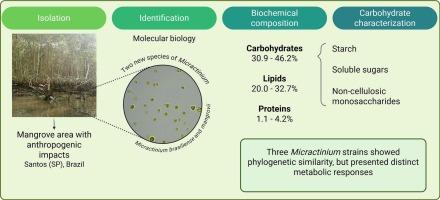通过系统发育分析和巴西红树林微藻碳水化合物组成揭示代谢多样性
IF 4.5
2区 生物学
Q1 BIOTECHNOLOGY & APPLIED MICROBIOLOGY
Algal Research-Biomass Biofuels and Bioproducts
Pub Date : 2025-09-22
DOI:10.1016/j.algal.2025.104313
引用次数: 0
摘要
红树林发挥着至关重要的生态和生态系统作用,与它们的微生物群落密切相关。然而,它们的光自养成员,特别是微藻,在很大程度上仍未被探索。这些生态系统独特的自然特征,加上频繁的人为影响,对当地微生物群施加了选择压力,产生了具有重大生物技术潜力的菌株。本研究旨在分离、鉴定和生物化学表征巴西Baixada Santista (s本文章由计算机程序翻译,如有差异,请以英文原文为准。

Unveiling metabolic diversity through phylogenetic analysis and carbohydrate composition of microalgae isolated from mangroves in Brazil
Mangroves play a crucial ecological and ecosystem role, strongly linked to their microbial communities. However, their photoautotrophic members, particularly microalgae, remain largely unexplored. The unique natural characteristics of these ecosystems, combined with frequent anthropogenic impacts, impose selective pressures on the local microbiota, yielding strains with significant biotechnological potential. This study aimed to isolate, identify, and biochemically characterize the biomass of five microalgae from a mangrove in Baixada Santista (São Paulo, Brazil), focusing on a comprehensive analysis of carbohydrates. The isolated microalgae were identified using conventional genetic markers (18S and ITS), and their biochemical composition was evaluated after cultivation under stressful conditions. The non-structural and structural carbohydrates were characterized through soluble sugars (1.28–2.35 %), starch (11.90–22.39 %), non-cellulosic cell wall monosaccharides (11.57–18.85 %), and cellulose (0.10–6.53 %). All isolates belonged to the phylum Chlorophyta; one strain was identified as Chlorella, while the others were novel species within Micractinium genus (M. brasiliense and M. mangrovii). Three strains exhibited phylogenetically similar characteristics, but their carbohydrate profiles showed distinct metabolic differences, prompting discussions on diversity and genomic regulation mechanisms. Notably, M. brasiliense strain B2 accumulated 46 % total carbohydrates, with significant fractions being starch (19 %) and non-cellulosic wall monosaccharides (18 %). The responses observed under stressful conditions highlighted relevant aspects of cell wall characteristics, particularly in the genus Micractinium, thereby contributing to a still underexplored field. These findings underscore the biorefinery potential of these microalgae, particularly the applicability of their polysaccharide fractions, and highlight mangroves as promising sources of microbial strains with high biotechnological value.
求助全文
通过发布文献求助,成功后即可免费获取论文全文。
去求助
来源期刊

Algal Research-Biomass Biofuels and Bioproducts
BIOTECHNOLOGY & APPLIED MICROBIOLOGY-
CiteScore
9.40
自引率
7.80%
发文量
332
期刊介绍:
Algal Research is an international phycology journal covering all areas of emerging technologies in algae biology, biomass production, cultivation, harvesting, extraction, bioproducts, biorefinery, engineering, and econometrics. Algae is defined to include cyanobacteria, microalgae, and protists and symbionts of interest in biotechnology. The journal publishes original research and reviews for the following scope: algal biology, including but not exclusive to: phylogeny, biodiversity, molecular traits, metabolic regulation, and genetic engineering, algal cultivation, e.g. phototrophic systems, heterotrophic systems, and mixotrophic systems, algal harvesting and extraction systems, biotechnology to convert algal biomass and components into biofuels and bioproducts, e.g., nutraceuticals, pharmaceuticals, animal feed, plastics, etc. algal products and their economic assessment
 求助内容:
求助内容: 应助结果提醒方式:
应助结果提醒方式:


